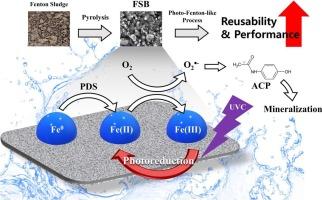紫外光还原驱动的异质芬顿类过程:芬顿污泥衍生生物炭的长期再活化和对乙酰氨基酚的强化降解
IF 6.3
2区 工程技术
Q1 ENGINEERING, CHEMICAL
引用次数: 0
摘要
Fenton 工艺因其独特的特性已被广泛应用于包括废水处理在内的各种领域,但如何处理其产生的铁污泥废物仍是一个难题。作为解决这一问题的可持续有效方法,有人提出了制备芬顿污泥(FS)生物炭(FSB)并将其用于水处理的建议。在本研究中,FSB 被用作紫外线诱导过硫酸钾(PDS)活化的催化剂,用于去除目标污染物对乙酰氨基酚(ACP)。FSB 是通过热解 FS(900 °C,120 分钟,N2 大气)制备的,X 射线衍射分析证实其表面存在零价铁(Fe0)和碳化铁(Fe3C)等铁元素。在批量实验中,FSB/PDS/UVC 系统对 ACP 的去除率为 100.0 ± 0.0 %(ACP = 20 mg/L,FSB = 0.2 g/L,PDS = 1 mM,时间 = 60 分钟),而 FSB/PDS/UVC 类光-芬顿系统对 ACP 的去除率常数(0.309 /min)高于 FSB/PDS 类光-芬顿系统(0.281 /min)。对 FSB/PDS/UVC 系统中 FSB 的可重复使用性进行了 15 次循环测试,结果表明,与 FSB/PDS 系统不同,ACP 降解率的催化性能保持稳定(99%)。总体而言,紫外线照射促进了光还原,加速了原位铁(II)/铁(III)氧化还原循环,提高了 FSB 的再生能力。这项研究为可持续的 FS 处理策略提供了启示,并突出了 FSB 在废水处理中的应用潜力。本文章由计算机程序翻译,如有差异,请以英文原文为准。

UV photoreduction-driven heterogeneous fenton-like process: Long-term reactivation of fenton sludge-derived biochar and enhanced acetaminophen degradation
The Fenton process has been employed in a wide range of applications, including the treatment of wastewater, due to its distinctive characteristics, but disposing of the iron sludge waste that it generates remains a challenge. As a sustainable and effective solution to this problem, the preparation of Fenton sludge (FS) biochar (FSB) and its subsequent use in water treatment has been proposed. In the present study, FSB was employed as a catalyst for the UVC-induced activation of potassium peroxydisulfate (PDS) in the removal of the target contaminant acetaminophen (ACP). The FSB was prepared by pyrolyzing FS (900 °C, 120 min, N2 atmosphere), and X-ray diffraction analysis confirmed the presence of iron such as zero-valent iron (Fe0) and iron carbide (Fe3C) on its surface. The FSB/PDS/UVC system achieved an ACP removal efficiency of 100.0 ± 0.0 % in a batch experiment (ACP = 20 mg/L, FSB = 0.2 g/L, PDS = 1 mM, time = 60 min), while the ACP removal rate constant was higher in the FSB/PDS/UVC photo-Fenton-like system (0.309 /min) than in the FSB/PDS Fenton-like system (0.281 /min). The reusability of the FSB in the FSB/PDS/UVC system was tested over 15 cycles and the results showed that, unlike the FSB/PDS system, the catalytic performance of the ACP degradation rate remained consistent (99 %). Overall, UVC irradiation promoted photoreduction, accelerating the in-situ Fe(II)/Fe(III) redox cycle and improving the regeneration of the FSB. This work provides insights into sustainable FS treatment strategies and highlights the potential for the use of FSB in wastewater treatment.
求助全文
通过发布文献求助,成功后即可免费获取论文全文。
去求助
来源期刊

Journal of water process engineering
Biochemistry, Genetics and Molecular Biology-Biotechnology
CiteScore
10.70
自引率
8.60%
发文量
846
审稿时长
24 days
期刊介绍:
The Journal of Water Process Engineering aims to publish refereed, high-quality research papers with significant novelty and impact in all areas of the engineering of water and wastewater processing . Papers on advanced and novel treatment processes and technologies are particularly welcome. The Journal considers papers in areas such as nanotechnology and biotechnology applications in water, novel oxidation and separation processes, membrane processes (except those for desalination) , catalytic processes for the removal of water contaminants, sustainable processes, water reuse and recycling, water use and wastewater minimization, integrated/hybrid technology, process modeling of water treatment and novel treatment processes. Submissions on the subject of adsorbents, including standard measurements of adsorption kinetics and equilibrium will only be considered if there is a genuine case for novelty and contribution, for example highly novel, sustainable adsorbents and their use: papers on activated carbon-type materials derived from natural matter, or surfactant-modified clays and related minerals, would not fulfil this criterion. The Journal particularly welcomes contributions involving environmentally, economically and socially sustainable technology for water treatment, including those which are energy-efficient, with minimal or no chemical consumption, and capable of water recycling and reuse that minimizes the direct disposal of wastewater to the aquatic environment. Papers that describe novel ideas for solving issues related to water quality and availability are also welcome, as are those that show the transfer of techniques from other disciplines. The Journal will consider papers dealing with processes for various water matrices including drinking water (except desalination), domestic, urban and industrial wastewaters, in addition to their residues. It is expected that the journal will be of particular relevance to chemical and process engineers working in the field. The Journal welcomes Full Text papers, Short Communications, State-of-the-Art Reviews and Letters to Editors and Case Studies
 求助内容:
求助内容: 应助结果提醒方式:
应助结果提醒方式:


